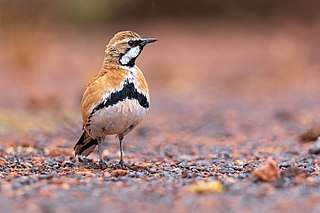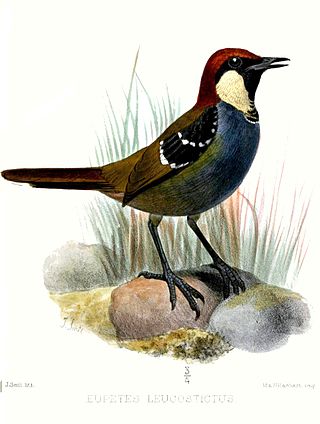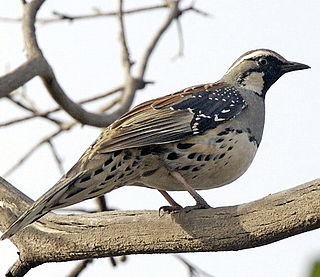
Psophodidae is a family of passerine birds native to Australia and nearby areas. It has a complicated taxonomic history and different authors vary in which birds they include in the family. In the strictest sense, it includes only the five or six species of whipbirds and wedgebills, but some authors also include the quail-thrushes (Cinclosoma), eight species of ground-dwelling birds found in Australia and New Guinea, and the jewel-babblers (Ptilorrhoa), three or four species found in rainforest in New Guinea. Others place them in their own family, the Cinclosomatidae. The Malaysian rail-babbler was formerly sometimes placed in this family, which would then be called Eupetidae.

The rail-babbler or Malaysian rail-babbler is a strange, rail-like, brown and pied ground-living bird. It is the only species in the genus Eupetes and family Eupetidae. It lives on the floor of primary forests in the Malay Peninsula and Sumatra, as well as Borneo. It is distantly related to African crow-like birds. Its population has greatly decreased because much of the lowland primary forest has been cut, and secondary forests usually have too dense a bottom vegetation or do not offer enough shade to be favourable for the species. However, it is locally still common in logged forest or on hill-forest on slopes, and probably not in immediate danger of extinction. The species is poorly known and rarely seen, in no small part due to its shyness.

The chestnut-breasted mannikin, also known as the chestnut-breasted munia or bully bird, is a small brown-backed munia with a black face and greyish crown and nape. It has a broad ferruginous breast bar above a white belly. The species is found in Australia, New Caledonia, Indonesia, and Papua New Guinea. This species has also been introduced to French Polynesia.

A quail-thrush is a bird of the genus Cinclosoma, which contains eight species. Quail-thrushes are in a different family from either quails or thrushes, but bear some superficial resemblance to them. The genus is found in Australia and New Guinea in a variety of habitats ranging from rainforest to deserts. The genus is closely related to the jewel-babblers of New Guinea. Seven species were recognised in 2007. A molecular study published in 2015 by Gaynor Dolman and Leo Joseph resulted in the splitting of the chestnut-backed quail-thrush into the chestnut quail-thrush of eastern Australia and the copperback quail-thrush in the west.

The Tacarcuna wood quail is a species of bird in the family Odontophoridae, the New World quail. It is found in Colombia and Panama.

The Chiriqui quail-dove or rufous-breasted quail-dove is a species of bird in the family Columbidae. It is found in Costa Rica and Panama.

The chestnut-breasted quail-thrush is a small endemic Australian bird which is predominantly found within the semi-arid deserts of New South Wales and Queensland.

The chestnut quail-thrush is a native Australian bird of the family Cinclosomatidae. These scrub birds are endemic to Australia and found in all states - barring Tasmania. They are relatively uncommon and are isolated to the semi-arid and arid fringes of the Australian interior.

The cinnamon quail-thrush is cryptic arid-zone species that is endemic to Australia. This small to medium-sized species of bird is found in the arid and semi-arid regions of central Australia.

The spotted quail-thrush is a species of bird in the family Cinclosomatidae. It is endemic to Australia.

The jewel-babblers are the bird genus Ptilorrhoa in the family Cinclosomatidae. The genus contains four species that are endemic to New Guinea. The genus was once considered to contain the rail-babbler, but that species is now considered to belong to its own family. The genus is closely related to the better known quail-thrushes (Cinclosoma) of New Guinea and Australia. Together with a number of other genera they comprise the family Cinclosomatidae, although the validity of this family as a whole has been questioned.

Whitehead's trogon is a species of bird in the family Trogonidae. It is endemic to the island of Borneo, where it is an uncommon resident in primary mountain forest. One of Borneo's largest trogons at 29 to 33 cm long, it is sexually dimorphic. The male is crimson on the head, nape, and underparts, with a black throat and grey chest; the rest of his upperparts are cinnamon-coloured. The female is similarly patterned, but cinnamon-brown where the male is scarlet. The species was first described for science by Richard Bowdler Sharpe in 1888, who named it for British explorer and collector John Whitehead. There are no subspecies.

The Nullarbor quail-thrush is a species of bird in the family Cinclosomatidae. It is the only Australian bird endemic to the Nullarbor Plain in southern Australia.

The copperback quail-thrush is a species of bird in the family Cinclosomatidae. It was split from the chestnut quail-thrush in 2015. It is endemic to Australia. Its natural habitat is Mediterranean-type shrubby vegetation.
A domesticated quail is a domestic form of the quail, a collective name which refers to a group of several small species of fowl. Thousands of years of breeding and domestication have guided the bird's evolution. Humans domesticated quails for meat and egg production; additionally, quails can be kept as pets. Domesticated quails are commonly kept in long wire cages and are fed game bird feed. The most common domesticated type is the Coturnix quail. Quails live on the ground, and rarely fly unless forced to do so.

Cinclosomatidae is a family of passerine birds native to Australia and New Guinea. It has a complicated taxonomic history and different authors vary in which birds they include in the family. It includes the quail-thrushes and jewel-babblers.
















